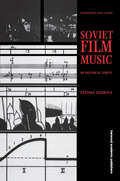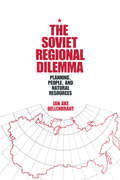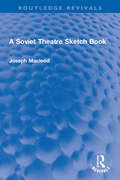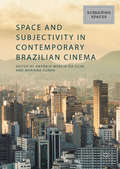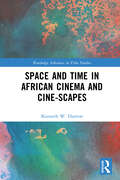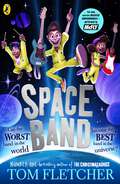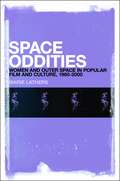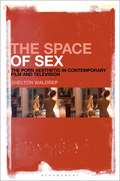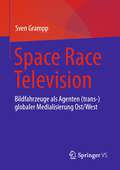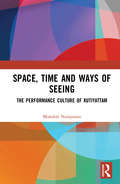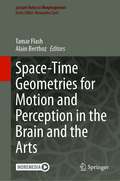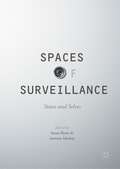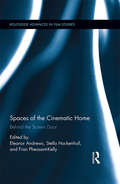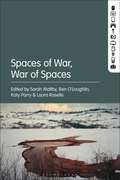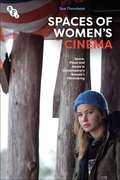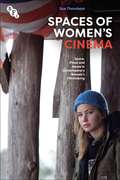- Table View
- List View
Soviet Film Music (Contemporary Music Studies)
by Tatiana EgorovaFirst Published in 1998. Routledge is an imprint of Taylor & Francis, an informa company.
The Soviet Regional Dilemma
by Jan Ake DellenbrantIncorporating an oral history approach, this history of radio covers the impact of the arrival of television, the rise of transistor radios, the popularity of rock n' roll, FM stereo stations, underground radio of the sixties, talk radio, public radio, and how technology will affect its future.
The Soviet Regional Dilemma
by Jan Ake DellenbrantIncorporating an oral history approach, this history of radio covers the impact of the arrival of television, the rise of transistor radios, the popularity of rock n' roll, FM stereo stations, underground radio of the sixties, talk radio, public radio, and how technology will affect its future.
A Soviet Theatre Sketch Book (Routledge Revivals)
by Joseph MacleodFirst Published in 1951, A Soviet Theatre Sketch Book presents Joseph Macleod’s take on Russian Theatre in a semi-fictional way to show the effect of the productions upon different audiences. By using his pen as an artist uses his pencil, he gives, for the first time, an account of theatre audiences as composed of individual human beings and is able to paint the scenes vividly without neglecting the technical methods of the Soviet stage. By supple use of the sketch- book form, theatres, theatre-schools, actors, and actresses including some no longer appearing are painted into an all-over view of Russian and Ukrainian post-war life. In this book the author writes less immediately about the Soviet Union and does not depend on topicality or stop press news. Joseph Macleod and his wife visited the Soviet Union as the guests of the Russian and Ukrainian Societies for Cultural Relations with Foreign Countries. This book will be of interest to scholars and researchers of theatre, history of theatre, and performance studies.
A Soviet Theatre Sketch Book (Routledge Revivals)
by Joseph MacleodFirst Published in 1951, A Soviet Theatre Sketch Book presents Joseph Macleod’s take on Russian Theatre in a semi-fictional way to show the effect of the productions upon different audiences. By using his pen as an artist uses his pencil, he gives, for the first time, an account of theatre audiences as composed of individual human beings and is able to paint the scenes vividly without neglecting the technical methods of the Soviet stage. By supple use of the sketch- book form, theatres, theatre-schools, actors, and actresses including some no longer appearing are painted into an all-over view of Russian and Ukrainian post-war life. In this book the author writes less immediately about the Soviet Union and does not depend on topicality or stop press news. Joseph Macleod and his wife visited the Soviet Union as the guests of the Russian and Ukrainian Societies for Cultural Relations with Foreign Countries. This book will be of interest to scholars and researchers of theatre, history of theatre, and performance studies.
Space and Subjectivity in Contemporary Brazilian Cinema
by Antônio Márcio da Silva Mariana CunhaThis collection explores the emergence of new spatialities and subjectivities in Brazilian films produced from the 1990s onwards, a period that became known as the retomada, but especially in the cinema of the new millennium. The chapters take spatiality as a powerful tool that can reveal aesthetic, political, social, and historical meanings of the cinematographic image instead of considering space as just a formal element of a film. From the rich cross-fertilization of different theories and disciplines, this edited collection engages with the connection between space and subjectivity in Brazilian cinema while raising new questions concerning spatiality and subjectivity in cinema and providing new models and tools for film analysis.
Space and Subjectivity in Contemporary Brazilian Cinema
by Antônio Márcio da Silva Mariana CunhaThis collection explores the emergence of new spatialities and subjectivities in Brazilian films produced from the 1990s onwards, a period that became known as the retomada, but especially in the cinema of the new millennium. The chapters take spatiality as a powerful tool that can reveal aesthetic, political, social, and historical meanings of the cinematographic image instead of considering space as just a formal element of a film. From the rich cross-fertilization of different theories and disciplines, this edited collection engages with the connection between space and subjectivity in Brazilian cinema while raising new questions concerning spatiality and subjectivity in cinema and providing new models and tools for film analysis.
Space and Time in African Cinema and Cine-scapes (Routledge Advances in Film Studies)
by Kenneth W. HarrowThis book is the first of its kind to bring basic notions of contemporary physics to bear on African cine-scapes. In this book, renowned African cinema scholar Kenneth W. Harrow presents unique new ways to think about space and time in film, with a specific focus on African and African diasporic cinema. Through a series of case studies, he explores how cinema creates and represents time and space and, more specifically, how a cinema centered in African landscapes and figures accomplishes this. He reflects on the issues and problems posed by scientists when faced with the basic questions of what space and time are and their solutions or conclusions, giving both film studies and African studies scholars access to new ways to formulate their thinking about African cine-scapes. Working beyond the limits of a framework based in a postcolonial and cultural understanding of time and space, Harrow demonstrates how a scientific understanding of time and space can open up new approaches to African cinema and cinema in general. A unique, interdisciplinary book that encourages brand new ways to approach cinematic texts and, specifically, African cine-scapes.
Space and Time in African Cinema and Cine-scapes (Routledge Advances in Film Studies)
by Kenneth W. HarrowThis book is the first of its kind to bring basic notions of contemporary physics to bear on African cine-scapes. In this book, renowned African cinema scholar Kenneth W. Harrow presents unique new ways to think about space and time in film, with a specific focus on African and African diasporic cinema. Through a series of case studies, he explores how cinema creates and represents time and space and, more specifically, how a cinema centered in African landscapes and figures accomplishes this. He reflects on the issues and problems posed by scientists when faced with the basic questions of what space and time are and their solutions or conclusions, giving both film studies and African studies scholars access to new ways to formulate their thinking about African cine-scapes. Working beyond the limits of a framework based in a postcolonial and cultural understanding of time and space, Harrow demonstrates how a scientific understanding of time and space can open up new approaches to African cinema and cinema in general. A unique, interdisciplinary book that encourages brand new ways to approach cinematic texts and, specifically, African cine-scapes.
Space Band: The out-of-this-world new adventure from the number-one-bestselling author Tom Fletcher
by Tom FletcherThe out-of-this-world new adventure from number-one-bestselling author of The Danger Gang and The Christmasaurus: Tom Fletcher.George, Neila and Bash are the worst band on Earth. George wants them to be brilliant - but Neila has stage fright, and Bash is too distracted by his obsession with stars, aliens and faraway planets. But what they lack in talent and confidence, they make up for in heart.They're determined to blow their friends away at their school Battle of the Bands contest. But the moment they start to play...They're beamed up into space!!!Now the kids face an even bigger challenge: Battle of the Bands, but the intergalactic version. They're competing against alien bands from every galaxy! And if they don't win, they might never make it home again...Can the worst band on Earth become the best band in the universe?An intergalactically awesome tale of celebrating difference, believing in yourself, and the power of friendship.Listen to the intergalactically awesome SPACE BAND soundtrack now, performed by McFLY!
Space Oddities: Women and Outer Space in Popular Film and Culture, 1960-2000
by Marie LathersSpace Oddities examines the representation of women in outer space films from 1960 to 2000, with an emphasis on films in which women are either denied or given the role of astronaut. Marie Lathers traces an evolution in this representation from women as aliens and/or "assistant" astronauts, to women as astronaut wives, to women as astronauts themselves. Many popular films from the era are considered, as are earlier films (from Aelita Queen of Mars to Devil Girl From Mars) and historical records, literary fiction, and television shows (especially I Dream of Jeannie). Early 1960s attempts by women pilots to enter the Space Race are considered as is the media drama surrounding the death of Christa McAuliffe. In addition to its insightful film scholarship, this is an important addition to current reassessments of the Space Race. By applying insights from contemporary gender, race, and species theories to popular imaginings of women in space, the status of the Space Race as a cultural construct that reproduces and/or warps terrestrial gender structures is revealed.
Space Oddities: Women and Outer Space in Popular Film and Culture, 1960-2000
by Marie LathersSpace Oddities examines the representation of women in outer space films from 1960 to 2000, with an emphasis on films in which women are either denied or given the role of astronaut. Marie Lathers traces an evolution in this representation from women as aliens and/or "assistant" astronauts, to women as astronaut wives, to women as astronauts themselves. Many popular films from the era are considered, as are earlier films (from Aelita Queen of Mars to Devil Girl From Mars) and historical records, literary fiction, and television shows (especially I Dream of Jeannie). Early 1960s attempts by women pilots to enter the Space Race are considered as is the media drama surrounding the death of Christa McAuliffe. In addition to its insightful film scholarship, this is an important addition to current reassessments of the Space Race. By applying insights from contemporary gender, race, and species theories to popular imaginings of women in space, the status of the Space Race as a cultural construct that reproduces and/or warps terrestrial gender structures is revealed.
The Space of Sex: The Porn Aesthetic in Contemporary Film and Television
by Shelton WaldrepAs film and television become ever more focused on the pornographic gaze of the camera, the human body undergoes a metamorphosis, becoming both landscape and building, part of an architectonic design in which the erotics of the body spread beyond the body itself to influence the design of the film or televisual shot. The body becomes the mise-en-scène of contemporary moving imagery. Opening The Space of Sex, Shelton Waldrep sets up some important tropes for the book: the movement between high and low art; the emphasis on the body, looking, and framing; the general intermedial and interdisciplinary methodology of the book as a whole.The Space of Sex's second half focuses on how sex, gender, and sexuality are represented in several recent films, including Paul Schrader's The Canyons (2013), Oliver Stone's Savages (2012), Steven Soderbergh's Magic Mike (2012), Lars Von Trier's Nymphomaniac (2013), and Joseph Gordon-Levitt's Don Jon (2013). Each of these mainstream or independent movies, and several more, are examined for the ways they have attempted to absorb pornography, if not the pornography industry specifically, into their plot. According to Waldrep, the utopian elements of seventies porn get reprocessed in a complex way in the twenty-first century as both a utopian impulse-the desire to have sex on the screen, to re-eroticize sex as something positive and lacking in shame-with a mixed feeling about pornography itself, with an industry that can be seen in a dystopian light. In other words, sex, in our contemporary world, still does not come without compromise.
The Space of Sex: The Porn Aesthetic in Contemporary Film and Television
by Shelton WaldrepAs film and television become ever more focused on the pornographic gaze of the camera, the human body undergoes a metamorphosis, becoming both landscape and building, part of an architectonic design in which the erotics of the body spread beyond the body itself to influence the design of the film or televisual shot. The body becomes the mise-en-scène of contemporary moving imagery. Opening The Space of Sex, Shelton Waldrep sets up some important tropes for the book: the movement between high and low art; the emphasis on the body, looking, and framing; the general intermedial and interdisciplinary methodology of the book as a whole.The Space of Sex's second half focuses on how sex, gender, and sexuality are represented in several recent films, including Paul Schrader's The Canyons (2013), Oliver Stone's Savages (2012), Steven Soderbergh's Magic Mike (2012), Lars Von Trier's Nymphomaniac (2013), and Joseph Gordon-Levitt's Don Jon (2013). Each of these mainstream or independent movies, and several more, are examined for the ways they have attempted to absorb pornography, if not the pornography industry specifically, into their plot. According to Waldrep, the utopian elements of seventies porn get reprocessed in a complex way in the twenty-first century as both a utopian impulse-the desire to have sex on the screen, to re-eroticize sex as something positive and lacking in shame-with a mixed feeling about pornography itself, with an industry that can be seen in a dystopian light. In other words, sex, in our contemporary world, still does not come without compromise.
Space Race Television: Bildfahrzeuge als Agenten (trans-)globaler Medialisierung Ost/West
by Sven GramppDer Band bietet eine medientheoretisch ausgerichtete Perspektive auf das Space Race. Analysiert werden Spielfilme, Dokumentationen, Live-Berichterstattung im Fernsehen, Magazine, Briefmarken, Plakate, Konfettiparaden, die das Space Race in je spezifischer Weise ins Bild setzten und von ‚Ost‘ nach ‚West‘ und von ‚West‘ nach ‚Ost‘ transnational über den ‚Eisernen Vorhang‘ hinweg in Umlauf brachten. Gezeigt wird, wie sich die Berichterstattung über das Space Race dabei zwischen 1955 und 1975 als globalisierende Bilder-Verflechtungsgeschichte während des Kalten Krieges nacherzählen lässt.
Space, Time and Ways of Seeing: The Performance Culture of Kutiyattam
by Mundoli NarayananThis volume explores the constitutive role played by space in the performance of Kutiyattam. The only surviving form of Sanskrit theatre, Kutiyattam is distinctive in terms of its performance conventions and its unique culture of extensive elaboration and interpretation. Drawing upon the concepts of phenomenology on the processes of perception, particularly on the works of Edmund Husserl, Martin Heidegger and Maurice Merleau-Ponty, it analyses the role of space in the communicative structures of performance of Kutiyattam and its contribution to the production of meaning in theatre, especially in the context of contemporary theatre. The book explores the theatrical event as a phenomenon that comes into existence through a triangular relationship among the ‘ways of being’ of the performers, the ‘ways of seeing’ of the audience, and the space which brings them together. Based on this formulation, Kutiyattam is approached as a ‘theatre of elaboration,’ made possible by the ‘intimate,’ ‘proximal’ ways of seeing of the audience, in the particular theatrical space of the kūttampalaṃs, the temple theatres, where Kutiyattam has customarily been performed for more than five centuries. This volume will be of great interest to scholars and researchers of cultural studies, theatre and performance studies, cultural anthropology, phenomenology and South Asian studies.
Space, Time and Ways of Seeing: The Performance Culture of Kutiyattam
by Mundoli NarayananThis volume explores the constitutive role played by space in the performance of Kutiyattam. The only surviving form of Sanskrit theatre, Kutiyattam is distinctive in terms of its performance conventions and its unique culture of extensive elaboration and interpretation. Drawing upon the concepts of phenomenology on the processes of perception, particularly on the works of Edmund Husserl, Martin Heidegger and Maurice Merleau-Ponty, it analyses the role of space in the communicative structures of performance of Kutiyattam and its contribution to the production of meaning in theatre, especially in the context of contemporary theatre. The book explores the theatrical event as a phenomenon that comes into existence through a triangular relationship among the ‘ways of being’ of the performers, the ‘ways of seeing’ of the audience, and the space which brings them together. Based on this formulation, Kutiyattam is approached as a ‘theatre of elaboration,’ made possible by the ‘intimate,’ ‘proximal’ ways of seeing of the audience, in the particular theatrical space of the kūttampalaṃs, the temple theatres, where Kutiyattam has customarily been performed for more than five centuries. This volume will be of great interest to scholars and researchers of cultural studies, theatre and performance studies, cultural anthropology, phenomenology and South Asian studies.
Space-Time Geometries for Motion and Perception in the Brain and the Arts (Lecture Notes in Morphogenesis)
by Tamar Flash Alain BerthozThis book is based on a two-day symposium at the Paris Institute of Advanced Study titled "space-time geometries and movement in the brain and the arts". It includes over 20 chapters written by the leading scientists and artists who presented their related research studies at the symposium and includes six sections; the first three focus on space-time geometries in perception, action and memory while the last three focus on specific artistic domains: drawing and painting, dance, music, digital arts and robotics. The book is accompanied by a dedicated webpage including related images and videos. There is an ever-growing interest in the topics covered by this book. Space and time are of fundamental importance for our understanding of human perception, action, memory and cognition, and are entities which are equally important in physics, biology, neuroscience and psychology. Highly prominent scientists and mathematicians have expressed their belief that our bodies and minds shape the ways we perceive space and time and the physical laws we formulate. Understanding how the brain perceives motion and generates -bodily movements is of great significance. There is also growing interest in studying how space, time and movement subserve artistic creations in different artistic modalities (e.g., fine arts, digital and performing arts and music). This interest is inspired by the idea that artists make intuitive use of the principles and simplifying strategies used by the brain in movement generation and perception. Building upon new understanding of the spatio-temporal geometries subserving movement generation and perception by the brain we can start exploring how artists make use of such neuro --geometrical and neuro-dynamic representations in order to express artistic concepts and emotionally affect the human observers and listeners. Scientists have also started formulating new ideas of how aesthetic judgements emerge from the principles and brain mechanisms subserving motor control and motion perception.Covering novel and multidisciplinary topics, this advanced book will be of interest to neuroscientists, behavioral scientists, artificial intelligence and robotics experts, students and artists.
Spaces of Surveillance: States and Selves
by Susan Flynn Antonia MackayIn a world of ubiquitous surveillance, watching and being watched are the salient features of the lives depicted in many of our cultural productions. This collection examines surveillance as it is portrayed in art, literature, film and popular culture, and makes the connection between our sense of ‘self’ and what is ‘seen’. In our post-panoptical world which purports to proffer freedom of movement, technology notes our movements and habits at every turn. Surveillance seeps out from businesses and power structures to blur the lines of security and confidentiality. This unsettling loss of privacy plays out in contemporary narratives, where the ‘selves’ we create are troubled by surveillance. This collection will appeal to scholars of media and cultural studies, contemporary literature, film and art and American studies.
Spaces of the Cinematic Home: Behind the Screen Door (Routledge Advances in Film Studies)
by Stella Hockenhull Eleanor Andrews Fran Pheasant-KellyThis book examines the ways in which the house appears in films and the modes by which it moves beyond being merely a backdrop for action. Specifically, it explores the ways that domestic spaces carry inherent connotations that filmmakers exploit to enhance meanings and pleasures within film. Rather than simply examining the representation of the house as national symbol, auteur trait, or in terms of genre, contributors study various rooms in the domestic sphere from an assortment of time periods and from a diversity of national cinemas—from interior spaces in ancient Rome to the Chinese kitchen, from the animated house to the metaphor of the armchair in film noir.
Spaces of the Cinematic Home: Behind the Screen Door (Routledge Advances in Film Studies #42)
by Stella Hockenhull Eleanor Andrews Fran Pheasant-KellyThis book examines the ways in which the house appears in films and the modes by which it moves beyond being merely a backdrop for action. Specifically, it explores the ways that domestic spaces carry inherent connotations that filmmakers exploit to enhance meanings and pleasures within film. Rather than simply examining the representation of the house as national symbol, auteur trait, or in terms of genre, contributors study various rooms in the domestic sphere from an assortment of time periods and from a diversity of national cinemas—from interior spaces in ancient Rome to the Chinese kitchen, from the animated house to the metaphor of the armchair in film noir.
Spaces of War, War of Spaces
by Laura Roselle Sarah Maltby Katy Parry Ben O’LoughlinSpaces of War, War of Spaces provides a rich, international and multi-disciplinary engagement with the convergence of war and media through the conceptual lens of 'space'. 'Space' offers a profound, challenging and original framework through which notions of communication, embodiment, enactment, memory and power are interrogated not only in terms of how media spaces (traditional, digital, cultural, aesthetic, embodied, mnemonic) transform the conduct, outcomes and consequences of war for all involved, but how 'war' actors (political, military, survivors, victims) recreate space in a manner that is transformative across political, social, cultural and personal spheres. Foregrounding the work of artists, activists and practitioners alongside more traditional scholarly approaches Spaces of War, War of Spaces engages with the 'messiness' of war and media through the convergence of practice and theory, where showing and embodying is made explicit.
Spaces of War, War of Spaces
Spaces of War, War of Spaces provides a rich, international and multi-disciplinary engagement with the convergence of war and media through the conceptual lens of 'space'. 'Space' offers a profound, challenging and original framework through which notions of communication, embodiment, enactment, memory and power are interrogated not only in terms of how media spaces (traditional, digital, cultural, aesthetic, embodied, mnemonic) transform the conduct, outcomes and consequences of war for all involved, but how 'war' actors (political, military, survivors, victims) recreate space in a manner that is transformative across political, social, cultural and personal spheres. Foregrounding the work of artists, activists and practitioners alongside more traditional scholarly approaches Spaces of War, War of Spaces engages with the 'messiness' of war and media through the convergence of practice and theory, where showing and embodying is made explicit.
Spaces of Women's Cinema: Space, Place and Genre in Contemporary Women’s Filmmaking
by Sue ThornhamSue Thornham explores issues of space, place, time and gender in feminist filmmaking through an examination of a wide range of films by contemporary women filmmakers, ranging from the avant-garde to mainstream Hollywood. Beginning from questions about space itself and the way it has been gendered, she asks how representation functions in relation to space and time, and how this, too, is gendered, before moving to an exploration of how such questions might be considered in relation to women's filmmaking. In sections dealing with spaces from wilderness to city, she analyses in detail how these issues have been dealt with by women filmmakers, addressing the work of filmmakers such as Jane Campion, Kathryn Bigelow, Julie Dash, Maggie Greenwald, Patricia Rozema and Carol Morley, and films including 'An Angel at My Table' (1990), 'Daughters of the Dust' (1991) 'The Ballad of Little Jo' (1993), 'Winter's Bone' (2010), 'Zero Dark Thirty' (2012) and 'The Falling' (2014).
Spaces of Women's Cinema: Space, Place and Genre in Contemporary Women’s Filmmaking
by Sue ThornhamSue Thornham explores issues of space, place, time and gender in feminist filmmaking through an examination of a wide range of films by contemporary women filmmakers, ranging from the avant-garde to mainstream Hollywood. Beginning from questions about space itself and the way it has been gendered, she asks how representation functions in relation to space and time, and how this, too, is gendered, before moving to an exploration of how such questions might be considered in relation to women's filmmaking. In sections dealing with spaces from wilderness to city, she analyses in detail how these issues have been dealt with by women filmmakers, addressing the work of filmmakers such as Jane Campion, Kathryn Bigelow, Julie Dash, Maggie Greenwald, Patricia Rozema and Carol Morley, and films including 'An Angel at My Table' (1990), 'Daughters of the Dust' (1991) 'The Ballad of Little Jo' (1993), 'Winter's Bone' (2010), 'Zero Dark Thirty' (2012) and 'The Falling' (2014).
